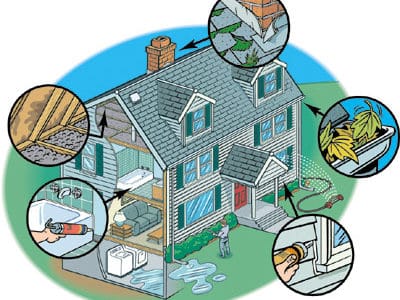How to Prevent Mold in Your House
Mold is a fungus that can grow in homes and cause health problems. Our homes are made from materials that support mold growth under the right conditions and moisture control inside of homes is the most important factor in prevention.
Microscopic mold spores everywhere and will germinate to form active colonies on porous surfaces when food, oxygen and water are available. Mold feeds on wood, paper and cloth. Most homes have paper-faced drywall, wood construction and cloth drapes and furnishings, so moisture control is the most important factor in preventing mold growth.
A water leak in your home can stimulate mold growth in just a day or two, so residents should take immediate action to fix any leaks from plumbing or outside water sources. Roof leaks other moisture sources are common causes of mold in attics. Poorly installed windows can allow rain to seep in at the walls and ground water can penetrate basements and crawlspaces.
Just because you can’t see evidence of mold within your home, doesn’t mean that you don’t have it. Mold thrives in environments where there is a lack of ventilation such as in wall cavities, sub-floors, beneath wall/floor coverings, behind vapor barriers, and behind ceiling tiles. If you can smell mold in your home, check that it isn’t coming from any food products in the kitchen and call a certified professional as soon as possible to investigate the potential problem and remediate as necessary.
Humid Weather and traditional home construction methods may facilitate mold growth. Improperly placed vapor retarder behind the gypsum board can cause condensation in the wall cavity if there is outside air infiltration.
In the attic, air conditioning condensate pans can overflow and condensation from leaky or poorly insulated ductwork will produce water and cause mold. Leaky or wet pipes under sinks, tub and showers are another common area for mold growth.
Control indoor moisture sources such as bathrooms and kitchens with ventilation fans. Bath and kitchen exhaust fans should be vented outdoors, not into the attic where mold can also form. If you notice condensation on the interior of your windows, additional ventilation may be needed.
If mold can be wiped off in the bathroom (tub, tiles, shower curtain), from windowsills, or sinks with a damp cloth and cleaning agent. If a small amount of mold (less than one square foot) is found elsewhere in the home, identify the source of excess water or moisture, fix the leak, and then clean up the mold.
Wash mold off tough surfaces with detergent or chlorine bleach and water, and dry completely. For porous materials hydrogen peroxid should be used to kill the mold. Absorbent materials like upholstery and carpets with mold may need to be replaced.
When cleaning moldy surfaces, wear gloves, goggles, and long sleeves to not expose your skin. To limit airborne exposure, wear a respirator (half-face breathers can be purchased at your local hardware shop). Make sure to adequately ventilate the space you are working in by opening windows and turning on exhaust fans to get some fresh air.
If the cause of the mold cannot be identified and/or if the mold growth is greater than one square foot, it is recommended to hire a mold consultant specializing in building assessments to evaluate the entire home.


Comments are closed.